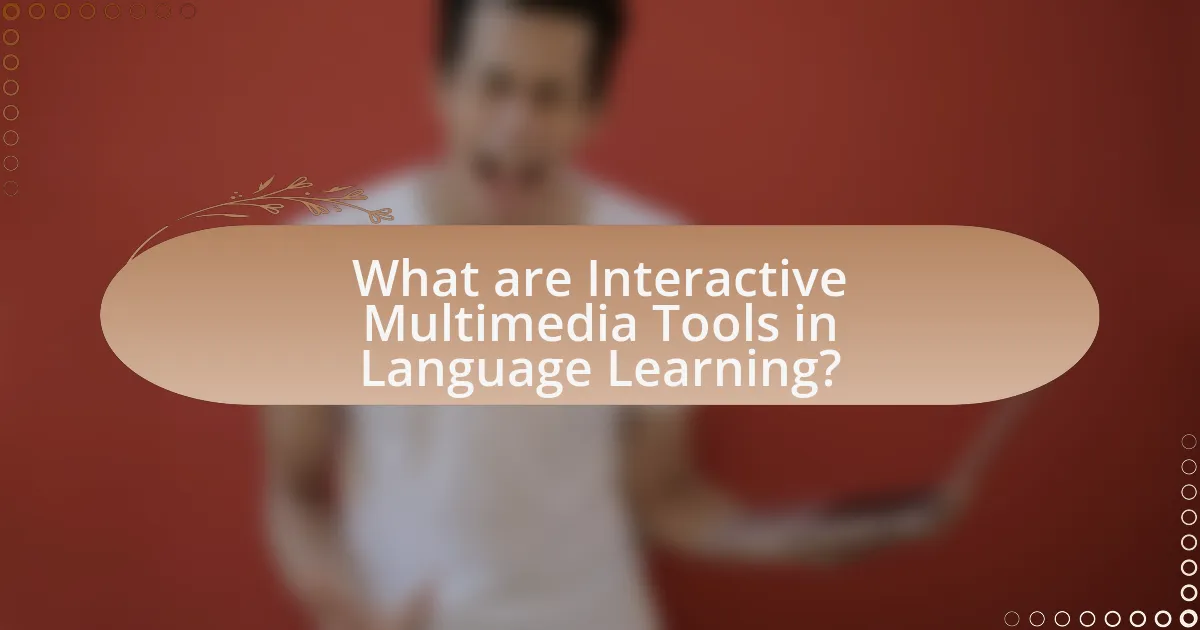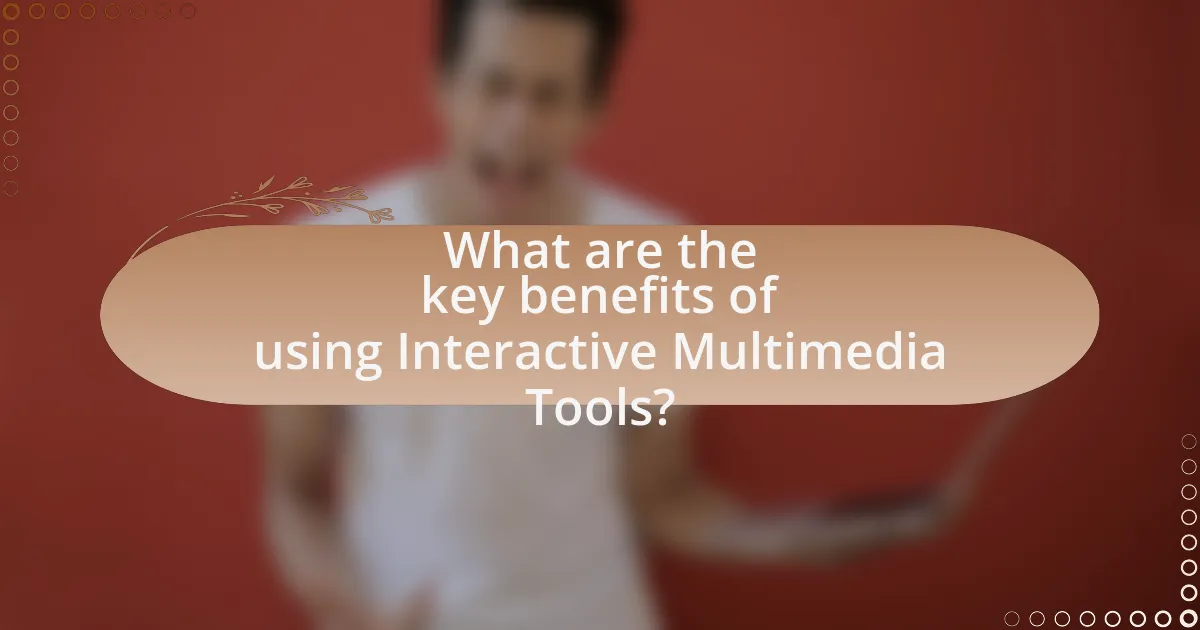Interactive multimedia tools in language learning are digital resources that integrate text, audio, video, and interactive elements to enhance language acquisition. These tools improve engagement and retention by catering to diverse learning styles and providing immersive experiences, as evidenced by research showing significant increases in language retention rates compared to traditional methods. The article explores how these tools facilitate personalized learning, the importance of interactivity, and the challenges associated with their implementation, while also highlighting best practices for educators to effectively integrate multimedia resources into their curriculum. Key benefits include enhanced motivation, improved comprehension, and the ability to adapt to individual learner needs, making interactive multimedia tools a vital component of modern language education.

What are Interactive Multimedia Tools in Language Learning?
Interactive multimedia tools in language learning are digital resources that combine text, audio, video, and interactive elements to facilitate the acquisition of a new language. These tools enhance engagement and comprehension by providing varied stimuli that cater to different learning styles. For instance, platforms like Duolingo and Rosetta Stone utilize gamification and multimedia content to create immersive learning experiences, which research has shown can improve retention rates and motivation among learners. Studies indicate that interactive multimedia tools can lead to a 30% increase in language retention compared to traditional methods, highlighting their effectiveness in modern language education.
How do Interactive Multimedia Tools enhance language acquisition?
Interactive multimedia tools enhance language acquisition by providing immersive and engaging learning experiences that cater to various learning styles. These tools, such as language learning apps, interactive videos, and online games, facilitate active participation, which has been shown to improve retention and understanding of new vocabulary and grammar structures. Research indicates that learners using multimedia resources demonstrate higher motivation and engagement levels, leading to more effective language practice. For instance, a study published in the “Journal of Educational Technology & Society” found that students using interactive multimedia tools scored significantly higher on language proficiency tests compared to those using traditional methods. This evidence supports the effectiveness of interactive multimedia tools in enhancing language acquisition.
What types of multimedia tools are commonly used in language learning?
Commonly used multimedia tools in language learning include language learning apps, interactive websites, audio-visual materials, and virtual reality platforms. Language learning apps like Duolingo and Babbel provide interactive exercises and gamified learning experiences, enhancing engagement and retention. Interactive websites such as BBC Languages offer a variety of resources, including videos and quizzes, to support diverse learning styles. Audio-visual materials, including podcasts and videos, facilitate listening comprehension and pronunciation practice. Virtual reality platforms create immersive environments for real-life language use, promoting conversational skills. These tools leverage technology to create dynamic and effective language learning experiences.
How do these tools cater to different learning styles?
Interactive multimedia tools cater to different learning styles by incorporating various modalities such as visual, auditory, and kinesthetic elements. For instance, visual learners benefit from graphics, videos, and infographics, while auditory learners engage with podcasts, music, and spoken instructions. Kinesthetic learners are supported through interactive simulations and hands-on activities that allow them to practice language skills in a tangible way. Research indicates that using multimedia tools can enhance retention and understanding by appealing to these diverse learning preferences, as evidenced by studies showing improved outcomes in language acquisition when multiple sensory channels are utilized.
Why is interactivity important in language learning?
Interactivity is important in language learning because it actively engages learners, facilitating better retention and understanding of the language. Engaging with interactive tools, such as language apps or conversation simulations, allows learners to practice speaking, listening, and comprehension skills in real-time, which enhances their ability to use the language in practical situations. Research indicates that interactive learning environments can improve language acquisition rates by up to 30%, as they provide immediate feedback and opportunities for learners to apply their knowledge in context.
How does interactivity improve engagement and retention?
Interactivity improves engagement and retention by actively involving learners in the educational process, which enhances their motivation and focus. When learners participate in interactive activities, such as quizzes, simulations, or discussions, they are more likely to retain information because these methods promote active learning rather than passive consumption. Research indicates that interactive learning environments can lead to a 75% increase in retention rates compared to traditional methods, as demonstrated in a study by the University of Colorado, which found that students who engaged in interactive learning scored significantly higher on assessments than those who did not. This evidence supports the notion that interactivity fosters deeper cognitive processing, leading to improved learning outcomes.
What role does feedback play in interactive learning environments?
Feedback plays a crucial role in interactive learning environments by facilitating immediate assessment and guiding learners toward improvement. In these settings, feedback helps learners understand their strengths and weaknesses, allowing them to adjust their strategies and enhance their language skills effectively. Research indicates that timely and specific feedback can significantly increase learner engagement and motivation, as it provides clear direction for progress. For instance, a study by Hattie and Timperley (2007) in “Review of Educational Research” highlights that feedback is one of the most powerful influences on student achievement, emphasizing its importance in interactive contexts.

What are the key benefits of using Interactive Multimedia Tools?
The key benefits of using Interactive Multimedia Tools include enhanced engagement, improved retention, and personalized learning experiences. These tools combine various media formats, such as text, audio, video, and interactive elements, which cater to different learning styles and keep learners actively involved. Research indicates that students using multimedia resources demonstrate a 50% higher retention rate compared to traditional methods, as they can visualize concepts and interact with content. Additionally, these tools allow for adaptive learning paths, enabling learners to progress at their own pace, which has been shown to increase motivation and overall learning outcomes.
How do these tools facilitate personalized learning experiences?
Interactive multimedia tools facilitate personalized learning experiences by adapting content to individual learner needs and preferences. These tools utilize algorithms to assess a learner’s progress, strengths, and weaknesses, allowing for customized lesson plans and resources. For instance, platforms like Duolingo employ adaptive learning technologies that modify exercises based on user performance, ensuring that learners engage with material that is appropriately challenging. Research indicates that personalized learning can lead to improved engagement and retention rates, as evidenced by a study published in the Journal of Educational Psychology, which found that students using adaptive learning tools showed a 30% increase in retention compared to traditional methods.
What features allow for customization in language learning?
Customization in language learning is facilitated by features such as personalized learning paths, adaptive assessments, and user-generated content. Personalized learning paths allow learners to select topics and materials that align with their interests and proficiency levels, enhancing engagement and motivation. Adaptive assessments adjust the difficulty of questions based on the learner’s performance, ensuring that the challenges presented are appropriate for their skill level. User-generated content enables learners to create and share their own materials, fostering a sense of ownership and relevance in their learning experience. These features collectively enhance the effectiveness of language learning by catering to individual needs and preferences.
How do learners benefit from adaptive learning technologies?
Learners benefit from adaptive learning technologies by receiving personalized educational experiences tailored to their individual needs and learning paces. These technologies analyze learners’ performance in real-time, allowing for immediate adjustments in content delivery and instructional strategies. Research indicates that personalized learning can lead to improved engagement and retention rates; for instance, a study by the Bill & Melinda Gates Foundation found that adaptive learning systems can increase student performance by up to 30% compared to traditional methods. This adaptability ensures that learners are neither overwhelmed nor under-challenged, fostering a more effective and efficient learning environment.
What impact do Interactive Multimedia Tools have on motivation?
Interactive Multimedia Tools significantly enhance motivation in learners by providing engaging and interactive experiences. These tools, such as educational games, videos, and simulations, cater to diverse learning styles and preferences, making the learning process more enjoyable. Research indicates that when learners interact with multimedia content, their intrinsic motivation increases, as evidenced by a study published in the Journal of Educational Psychology, which found that students using multimedia tools reported higher levels of engagement and interest compared to traditional learning methods. This increased motivation can lead to improved learning outcomes and greater retention of information.
How do gamification elements influence learner motivation?
Gamification elements significantly enhance learner motivation by incorporating game-like features such as points, badges, and leaderboards into educational contexts. These elements create a sense of achievement and competition, which can lead to increased engagement and persistence in learning tasks. Research by Hamari, Koivisto, and Sarsa (2014) indicates that gamification can improve user engagement and motivation by providing immediate feedback and rewards, which are crucial for maintaining interest and encouraging continued effort in learning activities.
What evidence supports the effectiveness of multimedia in maintaining interest?
Multimedia effectively maintains interest by engaging multiple senses, which enhances cognitive processing and retention. Research by Mayer (2001) in “Multimedia Learning” demonstrates that learners exposed to both visual and auditory information show improved understanding and motivation compared to those receiving information through a single modality. Additionally, a study by Moreno and Mayer (2000) found that students using multimedia resources reported higher levels of engagement and interest, as the interactive elements foster active participation. These findings indicate that multimedia not only captures attention but also sustains it through varied sensory stimulation and interactivity.

What challenges are associated with Interactive Multimedia Tools?
Interactive multimedia tools face several challenges, including technical issues, user engagement, and accessibility. Technical issues often arise from software compatibility, requiring users to have specific hardware or software configurations, which can limit access. User engagement can be difficult to maintain, as learners may become overwhelmed by excessive information or poorly designed interfaces, leading to decreased motivation. Accessibility is another significant challenge, as not all users may have equal access to technology or the internet, which can hinder the effectiveness of these tools in diverse learning environments. According to a study published in the Journal of Educational Technology & Society, 30% of educators reported that technical difficulties were a major barrier to the effective use of multimedia tools in classrooms.
What technical issues can arise when using these tools?
Technical issues that can arise when using interactive multimedia tools for language learning include software compatibility problems, connectivity issues, and user interface challenges. Software compatibility problems occur when the tools do not function properly across different operating systems or devices, leading to disruptions in the learning experience. Connectivity issues can arise from unstable internet connections, which may hinder access to online resources or cause interruptions during interactive sessions. User interface challenges may include complex navigation or unclear instructions, making it difficult for learners to effectively engage with the tools. These issues can significantly impact the overall effectiveness of multimedia tools in enhancing language learning.
How can educators troubleshoot common technical problems?
Educators can troubleshoot common technical problems by systematically identifying the issue, consulting available resources, and applying practical solutions. First, they should clearly define the problem, such as connectivity issues or software malfunctions. Next, educators can refer to user manuals, online forums, or technical support from the software or hardware provider for guidance. For instance, if a multimedia tool fails to load, checking internet connectivity and restarting the device often resolves the issue. Additionally, educators can conduct regular maintenance checks and updates on their devices and software to prevent future problems. Research indicates that proactive troubleshooting can enhance the effectiveness of technology in educational settings, leading to improved learning outcomes.
What resources are available for support and training?
Resources available for support and training in enhancing language learning with interactive multimedia tools include online platforms, workshops, and instructional materials. Online platforms such as Duolingo and Rosetta Stone offer structured courses and interactive exercises that facilitate language acquisition. Workshops conducted by educational institutions or language organizations provide hands-on training in utilizing multimedia tools effectively. Additionally, instructional materials like textbooks and online guides often include sections on integrating multimedia resources into language learning, ensuring that educators and learners can access comprehensive support.
How can educators effectively integrate these tools into their curriculum?
Educators can effectively integrate interactive multimedia tools into their curriculum by aligning these tools with specific learning objectives and incorporating them into lesson plans. For instance, using language learning apps that provide real-time feedback can enhance student engagement and improve language acquisition. Research indicates that students using multimedia tools show a 30% increase in retention rates compared to traditional methods, as found in a study by the University of California, which highlights the effectiveness of interactive learning environments. By selecting tools that complement existing curriculum frameworks, educators can create a more dynamic and effective learning experience.
What strategies can be employed for successful implementation?
Successful implementation of interactive multimedia tools in language learning can be achieved through several strategies. First, integrating user-centered design ensures that the tools meet the specific needs of learners, enhancing engagement and effectiveness. Research indicates that when tools are tailored to user preferences, such as incorporating gamification elements, learners show increased motivation and retention rates.
Second, providing comprehensive training for educators on how to effectively use these tools is crucial. Studies have shown that teachers who receive targeted professional development are more likely to implement technology successfully in their classrooms, leading to improved student outcomes.
Third, establishing a feedback loop allows for continuous improvement of the tools based on user experiences. Data from pilot programs demonstrate that iterative feedback mechanisms can significantly enhance the usability and effectiveness of educational technologies.
Lastly, ensuring accessibility for all learners, including those with disabilities, is essential for successful implementation. The World Health Organization reports that inclusive educational practices lead to better learning outcomes for diverse student populations.
How can teachers assess the effectiveness of multimedia tools in their classes?
Teachers can assess the effectiveness of multimedia tools in their classes by evaluating student engagement, comprehension, and performance outcomes. By using surveys and feedback forms, educators can gather data on how students interact with the multimedia tools and their perceived value in learning. Additionally, analyzing test scores and assignment results before and after the implementation of these tools provides quantitative evidence of their impact. Research indicates that multimedia tools can enhance learning outcomes; for instance, a study by Mayer (2009) found that students using multimedia resources scored significantly higher on assessments compared to those who did not. This combination of qualitative and quantitative assessment methods allows teachers to make informed decisions about the effectiveness of multimedia tools in enhancing language learning.
What are some best practices for using Interactive Multimedia Tools in language learning?
Best practices for using Interactive Multimedia Tools in language learning include integrating diverse media formats, such as videos, audio, and interactive exercises, to cater to different learning styles. This approach enhances engagement and retention, as supported by research indicating that multimedia learning can improve comprehension and recall by up to 50%. Additionally, providing opportunities for collaborative learning through these tools fosters communication skills and peer interaction, which are essential in language acquisition. Regularly assessing learners’ progress with interactive quizzes and feedback mechanisms ensures that the tools are effectively meeting educational goals, thereby optimizing the learning experience.
How can educators create a balanced approach to multimedia use?
Educators can create a balanced approach to multimedia use by integrating various types of multimedia tools while ensuring that they align with learning objectives. This involves selecting multimedia resources that cater to different learning styles, such as videos for visual learners and podcasts for auditory learners, thereby enhancing engagement and comprehension. Research indicates that diverse multimedia use can improve retention rates; for instance, a study by Mayer (2009) found that students who learned with a combination of visual and auditory materials performed better than those who used only one type. Additionally, educators should regularly assess the effectiveness of multimedia tools through student feedback and performance metrics, allowing for adjustments that maintain a focus on educational goals.
What tips can enhance the learning experience with these tools?
Utilizing interactive multimedia tools effectively can significantly enhance the language learning experience. Engaging with diverse formats, such as videos, podcasts, and interactive quizzes, caters to various learning styles and keeps learners motivated. Research indicates that multimedia learning can improve retention rates by up to 50% compared to traditional methods, as it stimulates multiple senses and encourages active participation. Additionally, incorporating regular feedback mechanisms, such as quizzes and progress tracking, allows learners to assess their understanding and adjust their study strategies accordingly. This approach not only reinforces knowledge but also fosters a sense of achievement, further motivating learners to continue their studies.